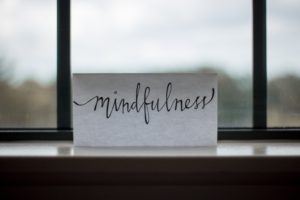I first became acquainted with the term mindfulness back in 2004 when I read an article about Mindfulness Based Eating. That led me to the work of John Kabat Zinn, who founded the Mindfulness Based Stress Reduction Program at the University of Massachusetts as a way to help patients recovering from heart attacks to keep their blood pressure down and relax. Now the term is very popular and that’s a good thing because the practice is one of the healthiest things we can do to better our lives.
I use a simple definition of mindfulness: nonjudgmental presence.
Let’s look at both parts.
Presence refers to bringing all of your attention to the present moment. This is no small task if you’ve tried it. I was raised to believe that multitasking was the key to success. Most of us have learned to dilute our attention. To be present, you have to be physically present with all of your senses, and mentally present with your mind. That means that you can’t be thinking about the past or the future.
Only this moment.
Right here.
Right now.
The nonjudgmental part is pretty self explanatory. Whatever you are experiencing in this moment is all greeted with acceptance. All thoughts, feelings and physical sensations. This is not our natural state. Most of us judge all the time. Our minds label things (especially done by other people) as right or wrong or good or bad. But we don’t limit our judging to others. We’re also quite good at judging ourselves.
So if you are practicing mindfulness, you are in a state of being aware and focused on what is going on right here and right now (presence) and you are in acceptance of it (nonjudgemental). It is referred to as a practice because it does not come naturally to most of us. When we feel anxious and uncertain (as I write this we are in the midst of the Coronavirus pandemic) our minds tend to leap into the future (which is always uncertain). The more we dedicate ourselves to a mindfulness practice, the more we can train our brain to stay here.
A mindfulness practice can look many different ways. We can be very mindful when we are doing yoga because we can use the asanas (poses) to focus our attention on the present moment and the sensations in our body and our breath. When judgmental thoughts arise (I can’t get my body to do that, my yoga clothes are not as nice as hers, my big boobs keep getting in the way….), we learn to observe them and let them go.
For me, I like to practice mindfulness meditation. I usually do about a 20 minute practice (you can do five minutes) where I close my eyes, take some centering breaths and then place all of my attention on my breath. The breath is a great anchor for our attention because it is always happening in the present moment. On my inhale, I like to practice feeling my breath in my body. And on my exhale, I remind myself to “stay”. Sometimes I say silently “in this moment”. Often my mind will wander and think about all kind of things. This is natural because this is what minds do. This is where we have to practice being nonjudgemental and just gently come back to the present moment and feel the breath. Feeling a sensation helps us to get out of our heads and back into the body and the present moment. Every time we come back to the present moment, we are strengthening that neural pathway in our brain to be present.
So it’s actually a good thing when we notice that we got distracted by our thoughts because it teaches us to come back.
So how does this help us in our relationships?
As someone who has spent 30 years listening to couples’ problems, I’d say that one of the biggest problems I see is what happens when there is conflict or disagreements.
Disagreement is neutral and normal. What becomes problematic is when we can’t communicate with each other without being reactive.
Reactivity is the problem.
I define it as responding from emotion instead of rational thinking. The even bigger problem occurs when that emotion includes layers of old, unexpressed emotion (more on that next time). So, instead of just reacting from the current emotion of (for example) anger or hurt, we react with rage or extreme distress. We know that reacting from strong emotion puts the lower brain (sometimes I refer to it as primitive brain) in charge, instead of our rational upper brain (prefrontal cortex).
Is it our best option for resolving conflict when we are reacting from strong emotion or when we can remain calm and access our PFC (prefrontal cortex)? I think you know the answer.
By practicing mindfulness daily, we train our brain to stay calm and can think more clearly and better access our heart wisdom. It allows us to respond instead of react.
Even if you’re not the one who is typically reactive in your relationship, you still probably have internal reactions when they are reactive. I know I do. But from a present, aware and nonjudgemental state, I can choose not to react externally.
With all of us quarantined at home, we are experiencing much more together time and more opportunities to get rattled. Please take some of this extra time that you are not commuting to work or going out to restaurants to add a ten minute mindfulness practice to your day.
Here’s a gift for you. It’s a 9 1/2 minute audio called The Eye of the Hurricane. I made it for you from a resource sent out by PositivePsychology.com.
Please let me know your thought on this or any questions. Just click on the comments button above next to the title.



I think we all forget, Arlette! That’s why it’s so important to practice regularly. The good news is that it feels really good to practice mindfulness. Unlike when I was 10 and I hated practicing piano 🙂
Thank you Ellen! This is very helpful and always a great tool. I get caught up in life and forget to be mindful.